China Brands, Marketing & Consumers
Series of Shocking Hit-and-Run Incidents: Ruining the Reputation of BMW in China?
The negative news coverage surrounding BMW in China starkly contradicts its marketing image.
Published
1 year agoon

Although it is one of China’s strongest luxury car brands, BMW often makes headlines in China in the context of horrific hit-and-run incidents. Lately, a series of incidents involving BMW drivers ramming into people received a lot of attention on social media. Are the negative headlines impacting BMW’s brand image in China?
Multiple incidents involving BMW drivers driving into crowds of people have attracted online attention in China recently. It is not the first time. BMW hit-and-run cases have made headlines in China since at least two decades ago.
With BMW as a car brand coming up so often in headlines concerning shocking cases, from drunk drivers ramming into people to BMW owners misbehaving in traffic, are attitudes towards the BMW car brand shifting in China?
Here, we will discuss some of the cases that have received a lot of attention on Chinese social media recently, and the role BMW as a brand plays in these discussions.
Three Hit-and-Run Cases Sparking Outrage
Drunk female driver drags victim along for over 1 kilometer in Loudi
On Tuesday, April 11, a court case related to a hit-and-run incident that involved a woman driving a BMW sparked online discussions. The incident happened in September of 2022 in Loudi City, Hunan Province. A female named Xiao (肖) drove into a person on an electrical bike who was then dragged along under the car for a kilometer before the car was finally stopped by traffic police.
Shocking footage of the scene spread online and sparked anger. As the driver was stopped – the victim was still underneath the BMW, – she seemed reluctant to cooperate and was busy staring at her phone. The 28-year-old driver turned out to be driving under influence and was arrested. After being rushed to the hospital, the victim’s condition stabilized.

According to her family, the victim had to stay at the intensive care unit until January of this year. Now, six months later, she is still unable to speak and cannot walk (#宝马女司机撞人拖行案受害者家属发声#).
Once the trial started at the Loudi People’s Court, the incident again went trending, especially because the court decided to postpone its verdict due to the “complexity of the case” (“称因案件疑难复杂将择期宣判”). The woman is accused of causing serious damage or injury while driving (交通肇事罪).
As the victim’s family spoke to reporters in the days leading up to the trial, it also became known that the driver’s family had tried to convince the victim’s husband on three different occasions to sign an apology letter, seeking to mitigate her sentence. They allegedly also told the victim’s family that the driver and her family were also “victims” in this case. This did not exactly help in gaining more sympathy from the public.
Liu Dong drove into Dalian pedestrians to take “revenge on society”
On May 22, 2021, a Saturday morning, a black BMW drove into a crowd of pedestrians in the northeastern Chinese city of Dalian, leaving five people dead and five injured. The driver, who was soon arrested, was a man by the name of Liu Dong (刘东), who reportedly purposely drove into the crowd to take “revenge on society” after an investment failure.
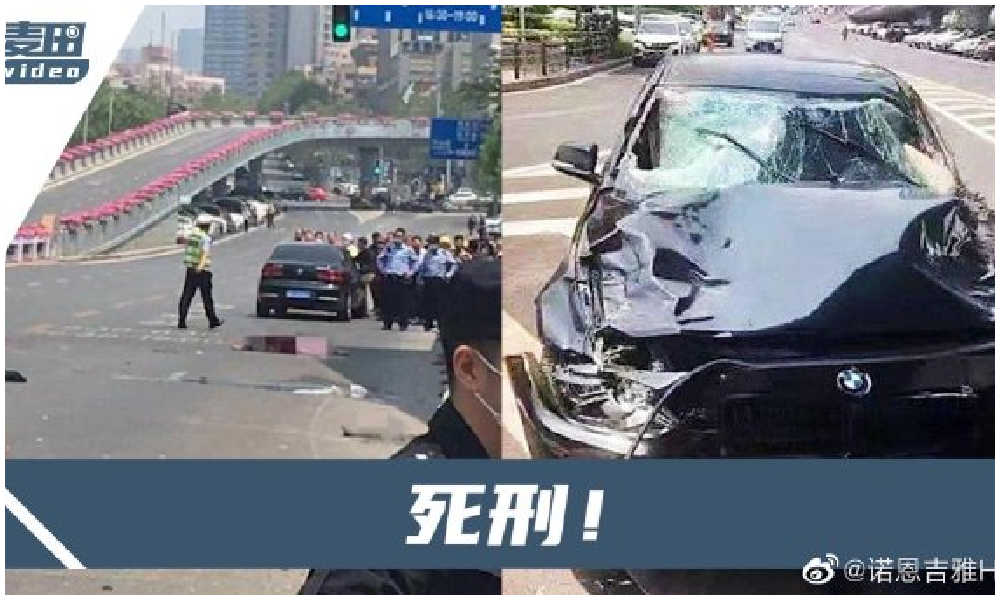
The case recently became trending again because, following his October 2021 trial and death penatly sentencing, Liu Dong was executed on April 7th, 2023.
On social media, the execution attracted a lot of attention. One related hashtag, “Dalian BMW Driver Who Drove Into People Executed by Death Penalty” (#大连宝马撞人案司机被执行死刑#), received over 230 million clicks.
22-year-old man ploughed his car through a busy Guangzhou intersection
Five people were killed and 13 others were injured in a traffic incident involving a BMW driving into pedestrians at Tianhe Road in Guangzhou on January 11, 2023. The incident recently received online attention again due to its similarity with the Dalian hit-and-run.
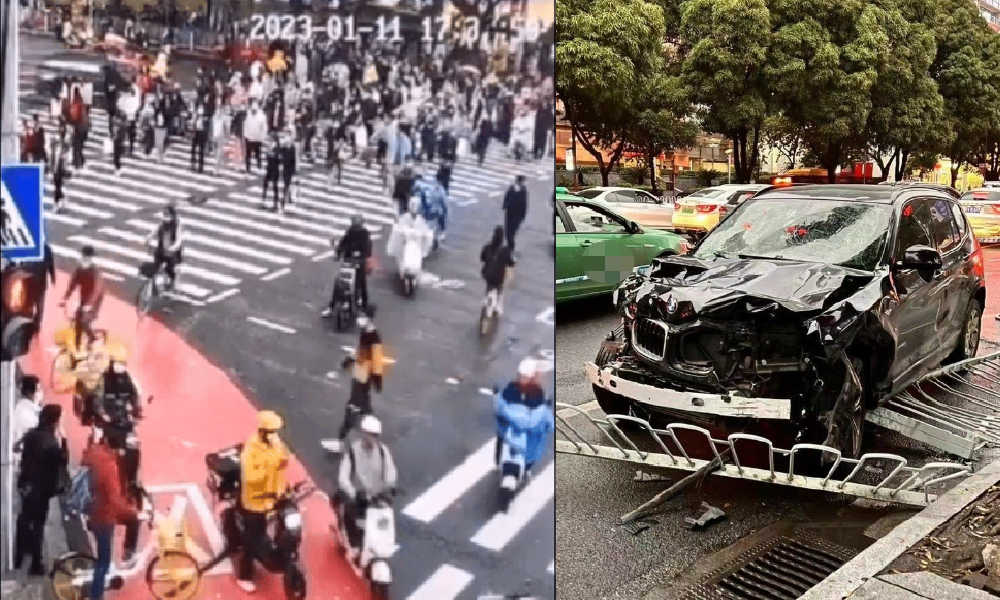
The incident happened around 17:25 local time. Videos circulating on Douyin and Weibo showed how the black SUV just ploughed his car through the busy street at Tianhe Road/Tiyu East Road, where dozens of people were walking and crossing the intersection. Shortly after the incident, some people could be seen lying motionless on the road.
The driver, who was later filmed driving into other people and throwing money out of his car window, was a 22-year-old man from Jieyang in Guangdong. He was arrested shortly after and there has not been an update in his case since.
The “BMWs Driving Into People” Phenomenon
The three aforementioned incidents are prominent cases in which drivers drove into people. In all of these cases, the BMW car brand was explicitly mentioned in related hashtags and headlines. But these are not the only shocking incidents in which the BMW brand was explicitly mentioned, as there have been so many more “BMW drives into people” cases (宝马撞人案件) throughout the years.
One of the earlier cases happened in October 2003 in Harbin, where a BMW car rammed into a crowd. The incident resulted in the death of one person and injured 12 others. The driver, Su Xiuwen (苏秀文), was later sentenced to two years in prison.
In another well-known incident, a 3-year-old boy in Xinyi, Jiangsu, died under the wheels of a BMW after being run over four times in less than 30 seconds. Although the incident was an accident, the driver drove off and did not even attempt to get help for the child.
In 2016, a BMW driver drove into a crowd in Shenyang, killing two people and injuring six. Other incidents happened in Nanjing (2011/2015), Dongguan (2012), Chengdu (2012), and in many others cities across China where drivers fled the scene after a collision, often causing injuries or killing people.
One other case that became one of the biggest trending topics on Chinese social media in 2018 was that of a Kunshan man driving a BMW who got out of his car in an act of shocking road rage, pulling a long knife to attack a cyclist. (In the end, the cyclist was able to grab the knife and he stabbed his attacker, who died from his injuries. The case was later determined to be an act of self-defense, resulting in the cyclists’s acquittal. This decision brought great joy to netizens who had supported the cyclist all along.)
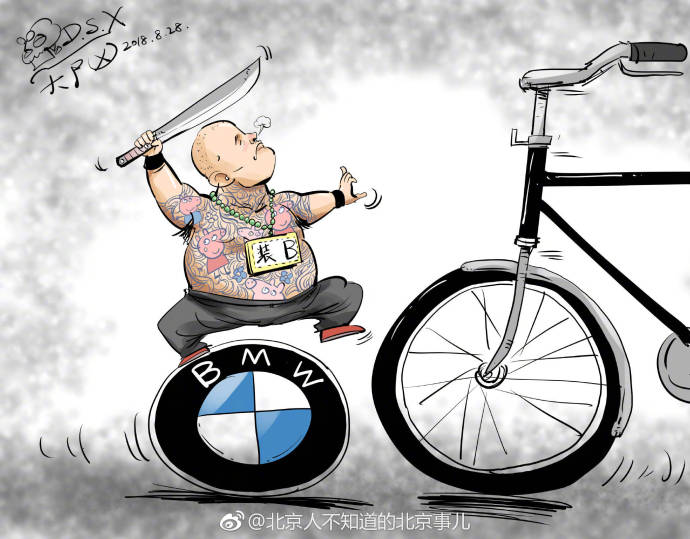
One of the cartoons that was published in the aftermath of the Kunshan BMW incident.
Back in 2010, author Meng Ke already wrote about the phenomenon of “BMWs driving into people” (“宝马撞人”) in China on the Chinese-language BBC website, suggesting the phrase had come to represent “being rich but immoral” (为富不仁). According to the article, the BMW brand was not just gaining a reputation as the car rich people like to drive, but also as the car they were using as a murder weapon.
“I Would Rather Cry in a BMW”
The idea that people driving a BMW are not just rich but also materialistic has been widespread in China for years, also reflected in the phrase “I would rather cry in a BMW” (宁愿宝马里哭) – a famous Chinese catchphrase and meme. The phrase became an online sensation in 2010 after it came up in the popular dating show Fei Cheng Wu Rao (非诚勿扰 If You Are the One).
Ma Nuo (马诺), a 20-year-old female contestant on the show, was asked if she would ride a bicycle with one of the male contestants. In response, she said she would “rather cry in a BMW than smile on a bicycle” (“我宁愿坐在宝马里哭,也不愿坐在自行车里笑”). Soon after, Ma was roasted by Chinese netizens, who attacked her for being a “gold digger” and criticized her for prioritizing material possessions above love. Ma suffered cyber bullying for years.
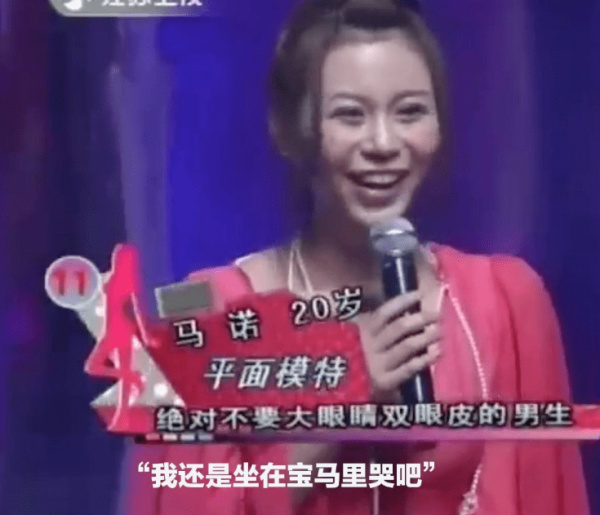
One reply on a dating show became a part of Chinese meme culture.
While BMW stands for Bayerische Motoren Werke AG, it is sometimes also jokingly said to stand for “Be My Wife,” which actually went viral due to a short Valentine Day film co-created by BMW which was released in 2021 (婚礼, link). It is also said to stand for “Bié Mō Wǒ” (别摸我), meaning “don’t touch me.” This literally conveys the idea of BMW owners being untouchable, and it comes from the popular 2006 film Crazy Stone (疯狂的石头).
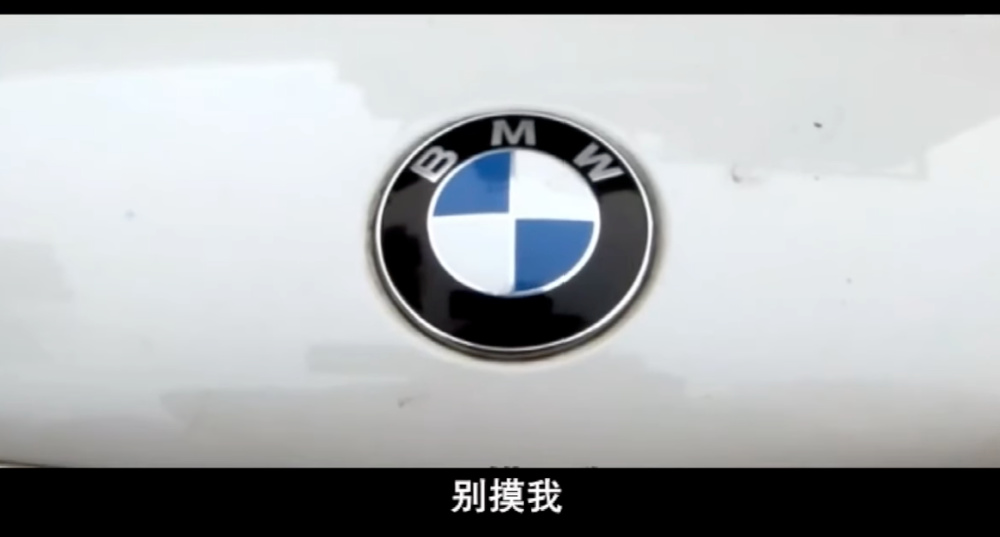
From the Crazy Stone movie, when a BMW car owner angrily scolds the person he got into an accident with, saying: “Didn’t you see [the BMW brand,] it stands for Don’t Touch Me (Bie Mo Wo)!”
The popularity of the “rather cry in a BMW,” “Bie Mo Wo,” and “Be My Wife” phrases shows the power of the BMW brand. In the eyes of many, it symbolizes money, capital, and status.
In fact, the success of BMW in the Chinese market – which it entered in 1994 – greatly relies on its brand image of not just producing high-quality, reliable, and superior cars, but also on its brand association with an active, luxurious, and stylish lifestyle (Wang 2013, 107-108).
The negative news coverage surrounding BMW thus starkly contradicts its marketing image, creating a jarring clash between the positive perception of the brand and the unfavorable publicity it has received.
It’s Not the Car, It’s the Rich People Who Drive It
In online discussions surrounding the recent hit-and-run incidents, it is not so much the BMW cars but the rich persons driving them who have a widespread negative reputation. This was also suggested by one popular car blogger on Zhihu (Youshi Qiche @优视汽车), who wrote that BMW owners in China have gotten a notoriously bad name throughout the years.
One study by the Hurun Research Institute on Chinese luxury brands (“中国豪华车品牌特性研究白皮书”) writes that Chinese BMW owners are perceived as being “high-profile and ostentatious, materialistic, showing-off, and lacking a sense of responsibility.” They are also seen as “enjoying new things, good at making friends, seeking social recognition, individualistic and flaunting their wealth.”
Another characteristic attributed to Chinese BMW owners is that they are “profiting without effort” or “reaping what they have not sown,” as they are often associated with China’s nouveau rich (暴发户 bào fā hù) or fù’ér dài (富二代), the ‘second generation rich’ who owe their wealth and lavish lifestyles to their parents’ success under China’s economic reforms.
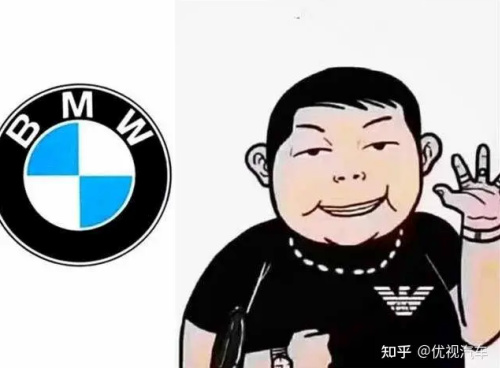
The BMW driver has gotten a bad reputation, image via Zhihu @优视汽车.
According to Youshi Qiche on Zhihu, some BMW owners only have themselves to blame for the negative stereotypes surrounding them. But what arguably plays a bigger role in their bad image is the social prejudice against those who are perceived as having excessive wealth or privileges, combined with the role media plays in the way they report on BMW owners causing trouble. When an accident involves a BMW or Porsche, it is more likely to be mentioned in the headlines and hashtags.
In many of the aforementioned incidents, but also in others that did not involve a BMW, rich and privileged people causing accidents – deliberately or not, – often try to shift responsibility and use their money, position, or network to avoid punishment.
The most well-known example of this, which has become a part of China’s internet culture, is the “My Dad is Li Gang” incident from 2010. The 22-year-old Li Qiming was drunk driving when he ran down two college students on the campus of Hebei University, killing one of them. When he was arrested after fleeing the scene of the accident, he yelled: “Sue me if you dare! My Dad is Li Gang!” (“我爸是李刚”). Li Gang was the deputy director of the local public security bureau.
“My Dad is Li Gang” instantly became a popular meme in China. Four years later, the sentence “Do you know who my dad is?” (“你知道我爸是谁阿”) became similarly famous after a young man who drove his BMW to school was caught cheating on an exam by a teacher and then intimidated them by suggesting his family was rich and powerful.
Although these incidents happened years ago, the sentiments have largely remained the same, and people are fed up with the careless, agressive and conceited behaviour displayed by nouveau riche who think they are invincible because of their status. These kinds of attitudes are associated with fraud and corruption – a sensitive social problem – and the recent incidents involving BMW drivers further reinforce preconceived beliefs about priviliged and ‘immoral’ BMW owners.
Despite all the negative news coverage in which BMW is mentioned, it is clear that the brand itself is not to blame for these horrific incidents. Nevertheless, the German multinational has shifted its marketing strategies in China over the past years and instead of purely focusing on pleasure, joy, and luxury, it is also placing more emphasis on social values and responsibility. As mentioned by Youshi Qiche, BMW China started sponsoring art and cultural projects, and is playing a role in creating awareness on traffic safety for Chinese children.

BMW China’s changing marketing strategies, images via Youshi Qishe (2021).
BMW’s current Chinese brand ambassador is the wildly popular singer and actor Jackson Yee (易烊千玺), who has a huge fanbase on social media. These kind of marketing strategies resonate with China’s younger generations, for whom the brand image of BMW will probably be different than the associations their parents have with the car.
After all, BMW is generally still seen as a prestigious and high-quality car brand, and it maintains its position as a leading luxury car brand in the Chinese market. Still, not all people prefer a BMW nowadays. “Remember that phrase ‘I’d rather cry in a BMW than smile on a bicycle?’ I’d now say it’s the other way around,” one Weibo user writes.
“I’d rather smile regardless,” another commenter said: “And if I could smile in my own BMW, then I’d go with that one.”
By Manya Koetse
Get the story behind the hashtag. Subscribe to What’s on Weibo here to receive our newsletter and get access to our latest articles:
References
Meng Ke (蒙克). 2010. “评论:宝马撞人成了为富不仁的同义词 [Commentary: ‘BMWs Driving Into People’ Has Become Synonymous with ‘the Immoral Rich People’].” BBC, September 14 https://www.bbc.com/zhongwen/simp/china/2010/09/100914_analysis_bmw [April 12, 2023].
Wang, Kangmao. 2013. Capital War : How Foreign Companies Fight Their War in China. China MBA Series, Paths International Limited.
Youshi Qiche (优视汽车). 2021. “20年过去了 宝马在国人心目中的品牌形象有改变吗 [After 20 Years, Has BMW’s Brand Image Changed in the Minds of the Chinese?”]. Zhihu, June 9 https://zhuanlan.zhihu.com/p/379235942 [April 12, 2023].
Spotted a mistake or want to add something? Please let us know in comments below or email us. First-time commenters, please be patient – we will have to manually approve your comment before it appears.
©2023 Whatsonweibo. All rights reserved. Do not reproduce our content without permission – you can contact us at info@whatsonweibo.com.
Manya Koetse is the founder and editor-in-chief of whatsonweibo.com. She is a writer, public speaker, and researcher (Sinologist, MPhil) on social trends, digital developments, and new media in an ever-changing China, with a focus on Chinese society, pop culture, and gender issues. She shares her love for hotpot on hotpotambassador.com. Contact at manya@whatsonweibo.com, or follow on Twitter.

China Brands, Marketing & Consumers
A Brew of Controversy: Lu Xun and LELECHA’s ‘Smoky’ Oolong Tea
Chinese tea brand LELECHA faced backlash for using the iconic literary figure Lu Xun to promote their “Smoky Oolong” milk tea, sparking controversy over the exploitation of his legacy.
Published
5 days agoon
May 3, 2024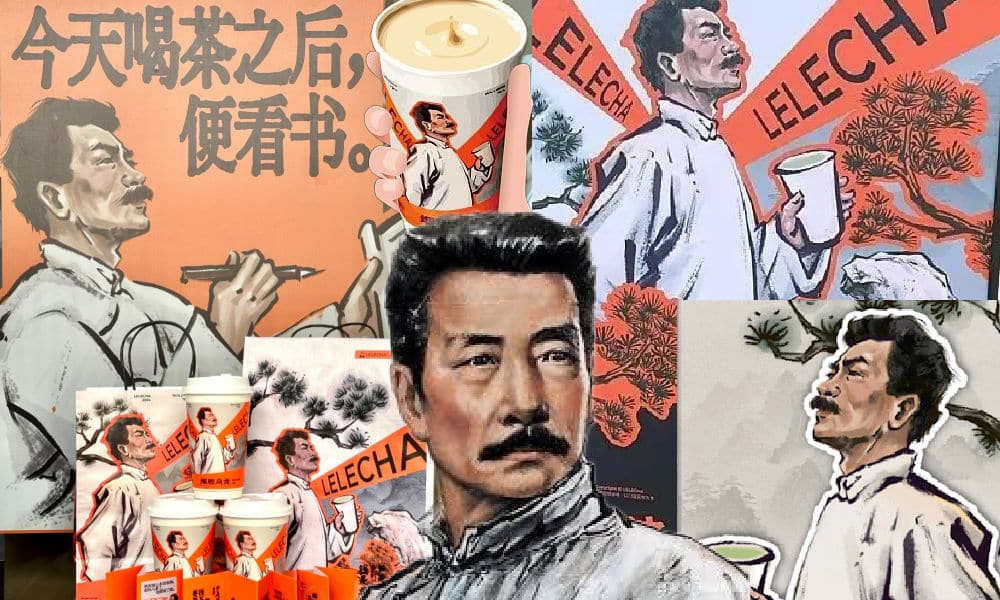
It seemed like such a good idea. For this year’s World Book Day, Chinese tea brand LELECHA (乐乐茶) put a spotlight on Lu Xun (鲁迅, 1881-1936), one of the most celebrated Chinese authors the 20th century and turned him into the the ‘brand ambassador’ of their special new “Smoky Oolong” (烟腔乌龙) milk tea.
LELECHA is a Chinese chain specializing in new-style tea beverages, including bubble tea and fruit tea. It debuted in Shanghai in 2016, and since then, it has expanded rapidly, opening dozens of new stores not only in Shanghai but also in other major cities across China.
Starting on April 23, not only did the LELECHA ‘Smoky Oolong” paper cups feature Lu Xun’s portrait, but also other promotional materials by LELECHA, such as menus and paper bags, accompanied by the slogan: “Old Smoky Oolong, New Youth” (“老烟腔,新青年”). The marketing campaign was a joint collaboration between LELECHA and publishing house Yilin Press.
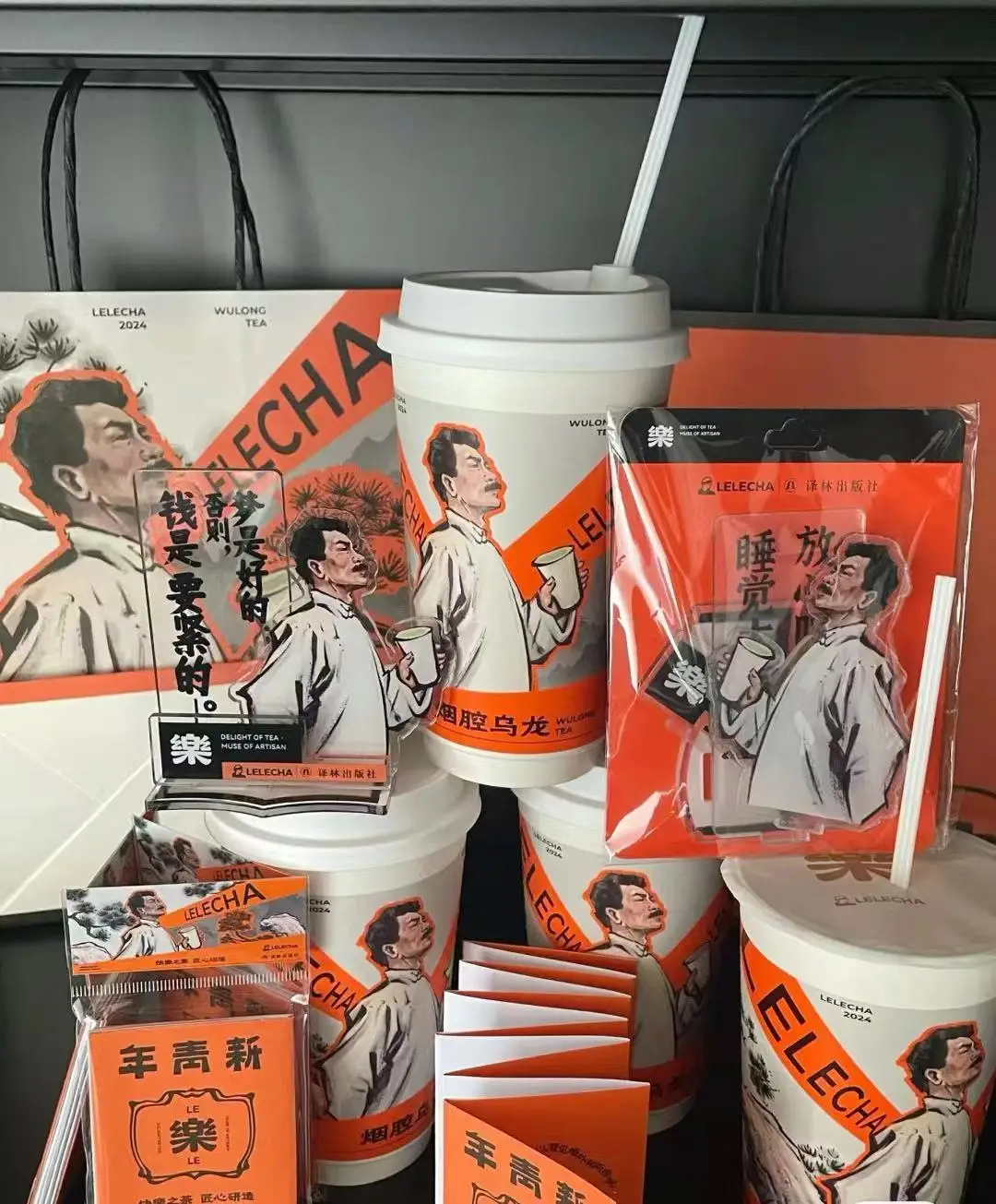
Lu Xun featured on LELECHA products, image via Netease.
The slogan “Old Smoky Oolong, New Youth” is a play on the Chinese magazine ‘New Youth’ or ‘La Jeunesse’ (新青年), the influential literary magazine in which Lu’s famous short story, “Diary of a Madman,” was published in 1918.
The design of the tea featuring Lu Xun’s image, its colors, and painting style also pay homage to the era in which Lu Xun rose to prominence.
Lu Xun (pen name of Zhou Shuren) was a leading figure within China’s May Fourth Movement. The May Fourth Movement (1915-24) is also referred to as the Chinese Enlightenment or the Chinese Renaissance. It was the cultural revolution brought about by the political demonstrations on the fourth of May 1919 when citizens and students in Beijing paraded the streets to protest decisions made at the post-World War I Versailles Conference and called for the destruction of traditional culture[1].
In this historical context, Lu Xun emerged as a significant cultural figure, renowned for his critical and enlightened perspectives on Chinese society.
To this day, Lu Xun remains a highly respected figure. In the post-Mao era, some critics felt that Lu Xun was actually revered a bit too much, and called for efforts to ‘demystify’ him. In 1979, for example, writer Mao Dun called for a halt to the movement to turn Lu Xun into “a god-like figure”[2].
Perhaps LELECHA’s marketing team figured they could not go wrong by creating a milk tea product around China’s beloved Lu Xun. But for various reasons, the marketing campaign backfired, landing LELECHA in hot water. The topic went trending on Chinese social media, where many criticized the tea company.
Commodification of ‘Marxist’ Lu Xun
The first issue with LELECHA’s Lu Xun campaign is a legal one. It seems the tea chain used Lu Xun’s portrait without permission. Zhou Lingfei, Lu Xun’s great-grandson and president of the Lu Xun Cultural Foundation, quickly demanded an end to the unauthorized use of Lu Xun’s image on tea cups and other merchandise. He even hired a law firm to take legal action against the campaign.
Others noted that the image of Lu Xun that was used by LELECHA resembled a famous painting of Lu Xun by Yang Zhiguang (杨之光), potentially also infringing on Yang’s copyright.
But there are more reasons why people online are upset about the Lu Xun x LELECHA marketing campaign. One is how the use of the word “smoky” is seen as disrespectful towards Lu Xun. Lu Xun was known for his heavy smoking, which ultimately contributed to his early death.
It’s also ironic that Lu Xun, widely seen as a Marxist, is being used as a ‘brand ambassador’ for a commercial tea brand. This exploits Lu Xun’s image for profit, turning his legacy into a commodity with the ‘smoky oolong’ tea and related merchandise.
“Such blatant commercialization of Lu Xun, is there no bottom limit anymore?”, one Weibo user wrote. Another person commented: “If Lu Xun were still alive and knew he had become a tool for capitalists to make money, he’d probably scold you in an article. ”
On April 29, LELECHA finally issued an apology to Lu Xun’s relatives and the Lu Xun Cultural Foundation for neglecting the legal aspects of their marketing campaign. They claimed it was meant to promote reading among China’s youth. All Lu Xun materials have now been removed from LELECHA’s stores.
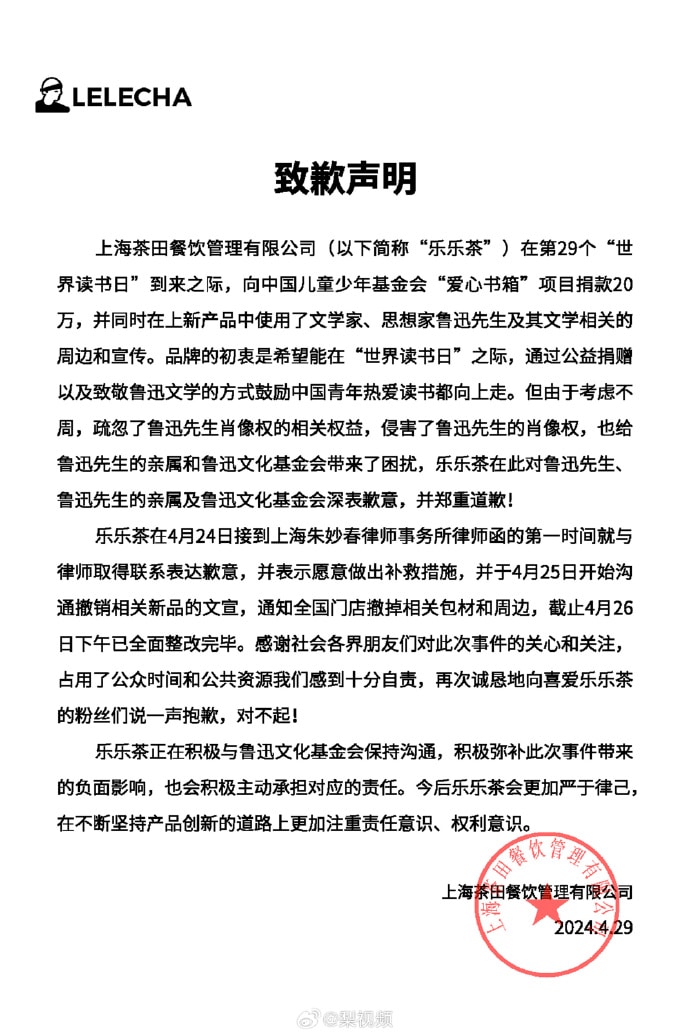
Statement by LELECHA.
On Chinese social media, where the hot tea became a hot potato, opinions on the issue are divided. While many netizens think it is unacceptable to infringe on Lu Xun’s portrait rights like that, there are others who appreciate the merchandise.
The LELECHA controversy is similar to another issue that went trending in late 2023, when the well-known Chinese tea chain HeyTea (喜茶) collaborated with the Jingdezhen Ceramics Museum to release a special ‘Buddha’s Happiness’ (佛喜) latte tea series adorned with Buddha images on the cups, along with other merchandise such as stickers and magnets. The series featured three customized “Buddha’s Happiness” cups modeled on the “Speechless Bodhisattva” (无语菩萨), which soon became popular among netizens.
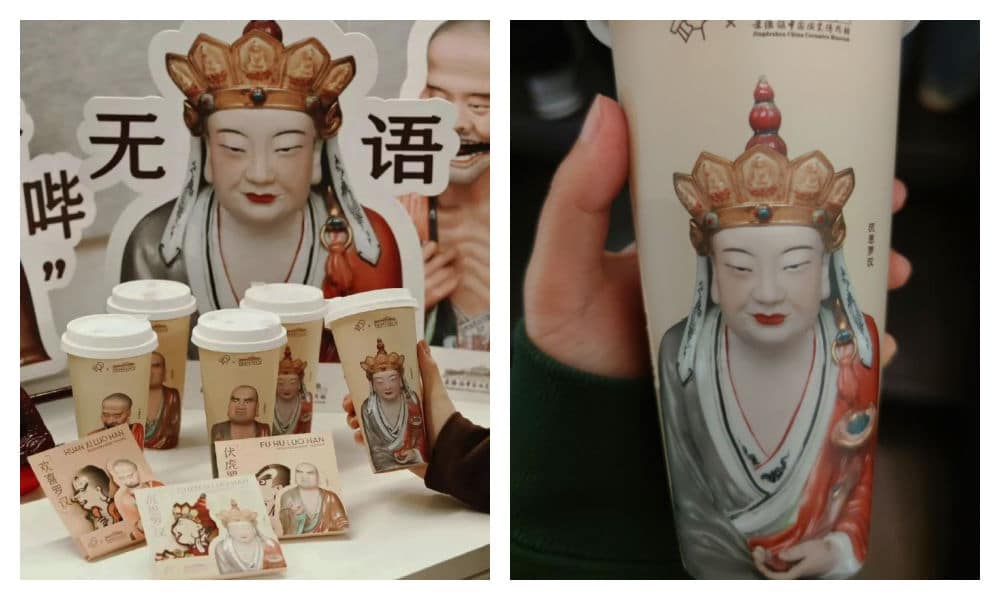
The HeyTea Buddha latte series, including merchandise, was pulled from shelves just three days after its launch.
However, the ‘Buddha’s Happiness’ success came to an abrupt halt when the Ethnic and Religious Affairs Bureau of Shenzhen intervened, citing regulations that prohibit commercial promotion of religion. HeyTea wasted no time challenging the objections made by the Bureau and promptly removed the tea series and all related merchandise from its stores, just three days after its initial launch.
Following the Happy Buddha and Lu Xun milk tea controversies, Chinese tea brands are bound to be more careful in the future when it comes to their collaborative marketing campaigns and whether or not they’re crossing any boundaries.
Some people couldn’t care less if they don’t launch another campaign at all. One Weibo user wrote: “Every day there’s a new collaboration here, another one there, but I’d just prefer a simple cup of tea.”
By Manya Koetse
[1]Schoppa, Keith. 2000. The Columbia Guide to Modern Chinese History. New York: Columbia UP, 159.
[2]Zhong, Xueping. 2010. “Who Is Afraid Of Lu Xun? The Politics Of ‘Debates About Lu Xun’ (鲁迅论争lu Xun Lun Zheng) And The Question Of His Legacy In Post-Revolution China.” In Culture and Social Transformations in Reform Era China, 257–284, 262.
Independently reporting China trends for over a decade. Like what we do? Support us and get the story behind the hashtag by subscribing:
Spotted a mistake or want to add something? Please let us know in comments below or email us. First-time commenters, please be patient – we will have to manually approve your comment before it appears.
©2024 Whatsonweibo. All rights reserved. Do not reproduce our content without permission – you can contact us at info@whatsonweibo.com.
China Brands, Marketing & Consumers
Zara Dress Goes Viral in China for Resemblance to Haidilao Apron
Who’s gonna buy this Zara dress in China? “I’m afraid that someone will say I stole the apron from Haidilao.”
Published
3 weeks agoon
April 19, 2024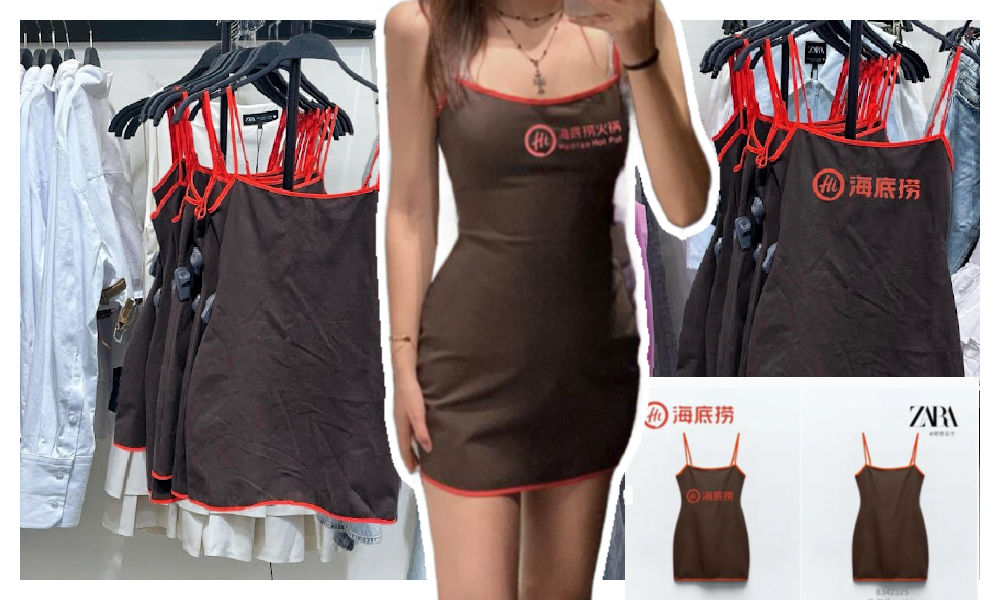
A short dress sold by Zara has gone viral in China for looking like the aprons used by the popular Chinese hotpot chain Haidilao.
“I really thought it was a Zara x Haidialo collab,” some customers commented. Others also agree that the first thing they thought about when seeing the Zara dress was the Haidilao apron.

The “original” vs the Zara dress.
The dress has become a popular topic on Xiaohongshu and other social media, where some images show the dress with the Haidilao logo photoshopped on it to emphasize the similarity.

One post on Xiaohongshu discussing the dress, with the caption “Curious about the inspiration behind Zara’s design,” garnered over 28,000 replies.
Haidilao, with its numerous restaurants across China, is renowned for its hospitality and exceptional customer service. Anyone who has ever dined at their restaurants is familiar with the Haidilao apron provided to diners for protecting their clothes from food or oil stains while enjoying hotpot.
These aprons are meant for use during the meal and should be returned to the staff afterward, rather than taken home.
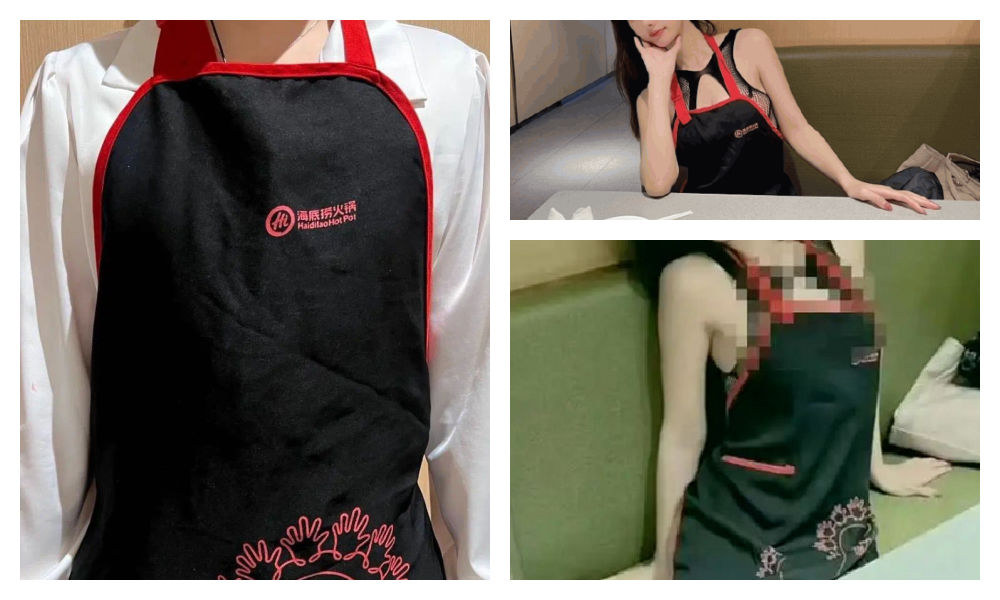
The Haidilao apron.
However, many people who have dined at Haidilao may have encountered the following scenario: after indulging in drinks and hotpot, they realize they are still wearing a Haidilao apron upon leaving the restaurant. Consequently, many hotpot enthusiasts may have an ‘accidental’ Haidilao apron tucked away at home somewhere.
This only adds to the humor of the latest Zara dress looking like the apron. The similarity between the Zara dress and the Haidilao apron is actually so striking, that some people are afraid to be accused of being a thief if they would wear it.
One Weibo commenter wrote: “The most confusing item of this season from Zara has come out. It’s like a Zara x Haidilao collaboration apron… This… I can’t wear it: I’m afraid that someone will say I stole the apron from Haidilao.”

Funnily enough, the Haidilao apron similarity seems to have set off a trend of girls trying on the Zara dress and posting photos of themselves wearing it.
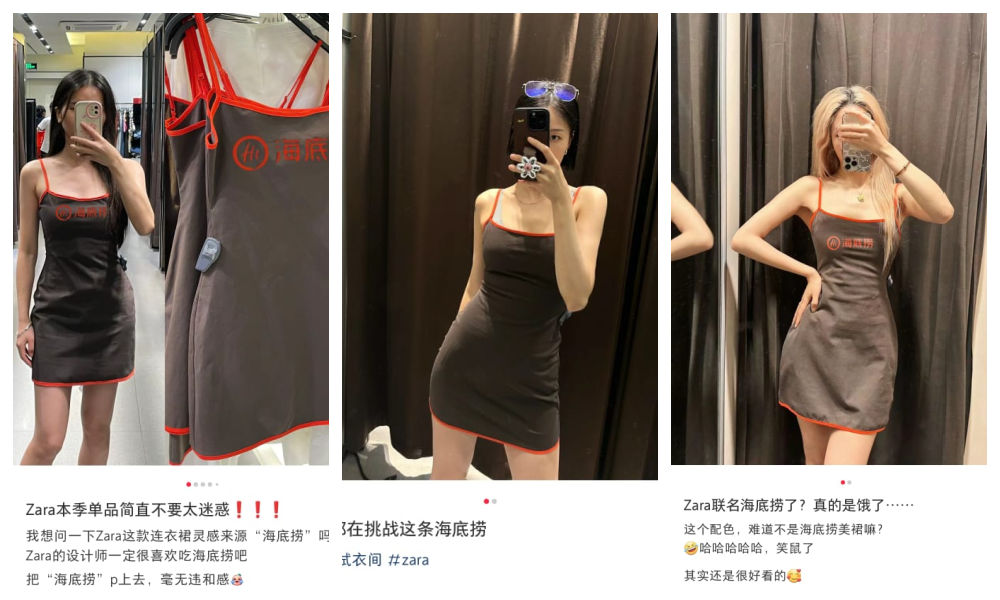
It’s doubtful that they’re actually purchasing the dress. Although some commenters say the dress is not bad, most people associate it too closely with the Haidilao brand: it just makes them hungry for hotpot.
By Manya Koetse
Independently reporting China trends for over a decade. Like what we do? Support us and get the story behind the hashtag by subscribing:
Spotted a mistake or want to add something? Please let us know in comments below or email us. First-time commenters, please be patient – we will have to manually approve your comment before it appears.
©2024 Whatsonweibo. All rights reserved. Do not reproduce our content without permission – you can contact us at info@whatsonweibo.com.
Subscribe

A Brew of Controversy: Lu Xun and LELECHA’s ‘Smoky’ Oolong Tea

Weibo Watch: The Battle for the Bottom Bed

Zara Dress Goes Viral in China for Resemblance to Haidilao Apron

“Old Bull Eating Young Grass”: 86-Year-Old Chinese Painter Fan Zeng Marries 36-Year-Old Xu Meng

Chengdu Disney: The Quirkiest Hotspot in China

The ‘Two Sessions’ Suggestions: Six Proposals Raising Online Discussions

Top 9 Chinese Movies to Watch This Spring Festival Holiday

“Old Bull Eating Young Grass”: 86-Year-Old Chinese Painter Fan Zeng Marries 36-Year-Old Xu Meng

Party Slogan, Weibo Hashtag: “The Next China Will Still Be China”

From Pitch to Politics: About the Messy Messi Affair in Hong Kong (Updated)

Chengdu Disney: The Quirkiest Hotspot in China

Looking Back on the 2024 CMG Spring Festival Gala: Highs, Lows, and Noteworthy Moments

More than Malatang: Tianshui’s Recipe for Success

Two Years After MU5735 Crash: New Report Finds “Nothing Abnormal” Surrounding Deadly Nose Dive

The Chinese Viral TikTok Song Explained (No, It’s Not About Samsung)
Get in touch
Would you like to become a contributor, or do you have any tips or suggestions? Get in touch here!
Popular Reads
-

 China Insight2 months ago
China Insight2 months agoThe ‘Two Sessions’ Suggestions: Six Proposals Raising Online Discussions
-

 China Arts & Entertainment3 months ago
China Arts & Entertainment3 months agoTop 9 Chinese Movies to Watch This Spring Festival Holiday
-

 China Arts & Entertainment3 weeks ago
China Arts & Entertainment3 weeks ago“Old Bull Eating Young Grass”: 86-Year-Old Chinese Painter Fan Zeng Marries 36-Year-Old Xu Meng
-

 China Media2 months ago
China Media2 months agoParty Slogan, Weibo Hashtag: “The Next China Will Still Be China”


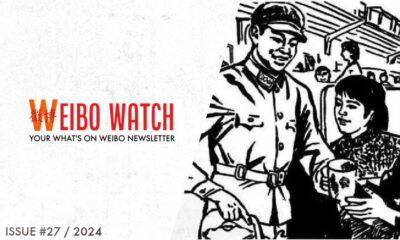


Duncan
April 17, 2023 at 1:18 am
BMW also stands for ‘Big Money Wasted’, or ‘Break My Windows’. Lol.